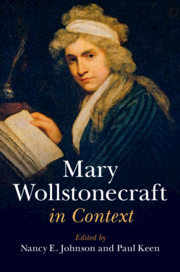Book contents
- Mary Wollstonecraft in Context
- Mary Wollstonecraft in Context
- Copyright page
- Contents
- Illustrations
- Notes on Contributors
- Preface
- Frontispiece
- Chronology
- Part I Life and Works
- Part II Critical Fortunes
- Part III Historical and Cultural Contexts
- The French Revolution Debate
- The Rights of Woman Debate
- Philosophical Frameworks
- Legal and Social Culture
- Chapter 23 The Constitution
- Chapter 24 Property Law
- Chapter 25 Domestic Law
- Chapter 26 Slavery and Abolition
- Chapter 27 The Bluestockings
- Chapter 28 Conduct Literature
- Chapter 29 Theories of Education
- Literature
- Suggested Further Reading
- Index
Chapter 27 - The Bluestockings
from Legal and Social Culture
Published online by Cambridge University Press: 16 January 2020
- Mary Wollstonecraft in Context
- Mary Wollstonecraft in Context
- Copyright page
- Contents
- Illustrations
- Notes on Contributors
- Preface
- Frontispiece
- Chronology
- Part I Life and Works
- Part II Critical Fortunes
- Part III Historical and Cultural Contexts
- The French Revolution Debate
- The Rights of Woman Debate
- Philosophical Frameworks
- Legal and Social Culture
- Chapter 23 The Constitution
- Chapter 24 Property Law
- Chapter 25 Domestic Law
- Chapter 26 Slavery and Abolition
- Chapter 27 The Bluestockings
- Chapter 28 Conduct Literature
- Chapter 29 Theories of Education
- Literature
- Suggested Further Reading
- Index
Summary
In her stinging critique of eighteenth-century writers on women’s education for “render[ing] women objects of pity, bordering on contempt,” Mary Wollstonecraft singles out Hester Chapone’s Letters on the Improvement of the Mind Addressed to a Young Lady as an exception, paying the work a “tribute of respect” for its “good sense, and unaffected humility, and … many useful observations.”1 Chapone’s Letters, first published in 1773 and republished or reprinted at least seventy times through to the middle of the nineteenth century,2 arose materially and intellectually out of her participation in the collective that has come to be called the Bluestockings. This chapter begins with brief sketches of three “first-generation” Bluestocking women as a means of identifying characteristic features of this eighteenth-century movement. I then review the Bluestockings’ influential model of sociability and their commitments to a rational and benevolent social order and to female education, before suggesting their complicated contribution to the British imagination of womanhood as the nation moved into the contested political territory of the end of the century. Chapone’s Bluestocking life and her resulting Letters serve as useful orientation points to this important context for Wollstonecraft’s thoughts on the nature of woman, women’s societal role, and the ideal education for that role.
- Type
- Chapter
- Information
- Mary Wollstonecraft in Context , pp. 230 - 237Publisher: Cambridge University PressPrint publication year: 2020



